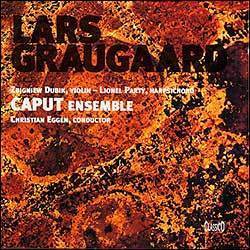 CLASSCD-189 Classico 1997 Lars Graugaard's first steps into compositions were due to the inherent limitations he experienced as an active flute performer of a broad spectrum of improvised music, mostly in contemporary jazz-styles ranging from ethnic influences to free forms. In 1977 he joined the Royal Danish Academy of Music from which he graduated six years later with a Diploma in Flute Performance. In 1982, challenged by the possibilities in the contemporary compositional idioms, he embarked as an autodidacte on a path that would lead to his identity as the composer presented on this CD. His music has been performed in most European countries and in the Americas. Lars Graugaard was artistic director of the ISCM World Music Days in Copenhagen 1996. - Body, Legs, Head (1996) for sinfonietta dedicated to CAPUT ensemble and Guðni. Premiered at the Gulbenkian Festival in Portugal, 1997
- Tongues Enrobed (1995) for ensemble and live electronics
- River and Leaf (1992) for solo violin and ensemble
- Black Walls (1995) for ensemble
- Broken Grammar (1995) for harpsichord and ensemble
- The Circle and the Web (1991) for sinfonietta.
Soloists: Zbigniew Dubik, violin and Lionel Partry, harpsichord The Norwegian conductor Christian Eggen conducted "Body, Legs, Head", "River and Leaf", "Broken Grammar" and "The Circle and the Web". Guðni Franzson conducted "Tongues Enrobed".
Recordings took place in August and October 1996 at Víðistaðakirkja, Iceland. Tonmeister: Bjarni Rúnar Bjarnason. © 2001 Kolbeinn Bjarnason The music:
Body, Legs, Head (1996): The piece arises from an initial gesture, which is repeated insistently and subsequently split into parts and pieces in interdependent motion. A brief march-like intrusion conveys new energy, and a completely different music emerges, dark, heavy and pulsating. Signals, events, and gestures appear and intermingle in a joint expression, leading to a flow of music reminiscent of the inside of the brain where images drift around and prickling thoughts are born.
Tongues Enrobed (1995): The music develops from the idea of a huge presence which hardly moves. The sound of two timpani and the interference between them is projected into other instruments which amplify, develop, and temporarily illuminate the dark colours. Attacked sounds evoke expectations of unknown events. A counterforce emerges and grows, a singing melody rises slowly, and glimpses of light and waves of pulse appear in contrast to the omnipresent waves of darkness, resulting in a breakthrough of contrasts where the timpani stands out clearly articulated in an open space.
River and Leaf (1992): This piece is a small-scale violin concerto, and this is evident on several levels. The piece is technically constructed by the means of spectral analysis of a violin tone played in a number of ways - ordinario, col legno, sul ponticello, sul tasto and with a bowed tremolo. These spectra have then been magnified into chords, and the ensemble is in a continuous flow between these spectra. The soloist is therefore at the same time playing by himself, and placed 'inside' or 'on top of' his own sound, as he is surrounded by the reproduced violin spectra. The sudden impulses and flowing energies of the ensemble becomes a continuos sound-flow, on top of which the soloist looks toward other and more subjective kinds of musical ideas. The image of a leaf floating on the waves of a stream seemed a fitting inspiration for the title for the piece.
Black Walls (1995): A field of vibrating energy is set in restless pulsating motion, trying to transcend its boundaries. Massive black walls become the target of incessant attacks. When a wall is penetrated, other walls appear, and in this process the energy field is transformed from transparent filigrees to dense structures of jagged rhythms. A further transformation takes place when massive chords in the piano take over the forward pulsating motion, driving out the other instruments and descending to the lowest register. When this barrier has been reached, the ensemble is reunited in final eruptions of energy.
Broken Grammar (1995): The harpsichord dominates the sound throughout the piece, which clearly falls in two sections. The first section is dominated by toccata-like playing in the harpsichord in it's lute register. The ensemble - always in very soft dynamics - is perceived to be dragged through the sound as a result of the pace of the harpsichord. The second section utilizes a recitativo playing by the harpsichord, which now uses its full register. Jagged tension and the element of surprise is pronounced in this section, but the generated energy is expelled. A short echo of the first section appears before the piece is brought to an end.
The Circle and the Web (1991): This piece grew out of the initial idea of a slow circular motion, resembling a huge barrel organ. The music begins with prolonged tension between high squeaking lines and slapping attacks on a backdrop of heavy, somber sound. Small snippets of faster music emerge and begin to combine into actual phrases. As these phrases gain momentum, long waves of circular motion appear, develop, and accelerate up to a climax. Abruptly, the tones of this motion are contracted into a single chord which continues in quiet flow. |
